.
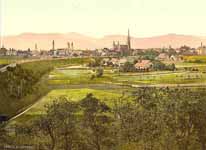
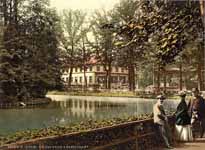
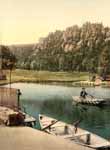
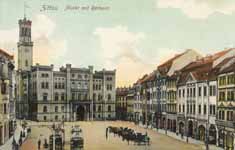

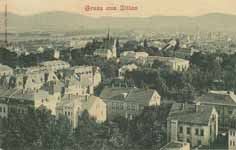

7,
Zittau
Zittau (Czech: Žitava, Polish: Żytawa, Upper Sorbian: Žitawa) is a city in the south east of the Free State of Saxony, Germany, close to the border tripoint of Germany, Poland, and the Czech Republic. As of 2009, there are 28,638 people in the city. It is part of the Görlitz district.
The inner city of Zittau still shows its original beauty with many houses from several periods of German architecture. There is the famous town hall built in an Italian style, the church of St. John and the stables (Salzhaus) with its medieval heritage. This multi-storied building is one of the oldest of its kind in Germany.
History
Zittau in 1744.
Zittau was one of the six members of the Six-City League of Upper Lusatia. At that time the city was granted a special title - it was called "Die Reiche" ("the Rich") because of its high proportion of well-to-do citizens.
During the Counterreformation and after 1620 after the battle at Weisser Berg (White Mountain) a large number of Protestant refugees from Bohemia (böhmische Exulanten) came to Zittau, where the Protestant Saxon rulers took them in. Many of them went on and found refuge in surrounding villages, in Dresden and in Berlin in Brandenburg. Primarily due to near-complete destruction caused by the Seven Years' War the former prosperous era of the city is only reflected in a few exceptional buildings and the cemeteries where the well-to-do were buried.
One of the most important trading goods of this early age in the 16th century was beer. Later in the 18th and 19th century textiles became important too, a tradition common in the region of Upper-Lusatia. During World War II, a labour camp was located in the city. It provided forced labour for Schoenmann Werke, an aircraft parts manufacturer.[2]
After the reunification in 1990 most of the big textile firms that survived the time of the GDR almost without any changes and any further investment closed down in just a few years. The city lost most of its economical strength. In addition, lignite surface mining was discontinued on the outskirts of the city in the foothills of the Zittau Mountains, while it still goes on across the border in Poland. This, however, has saved parts of the city from certain destruction, which are still primarily now dormant military garrisons and schools. The city is also disadvantaged by the cheaper labour from neighbouring countries.
Main sights
Church of our Lady - A semi-gothic church that is first mentioned in 1355.
City Hall - Designed by Karl Friedrich Schinkel and built in Italian-pallazo style between 1840 and 1845
Flower Clock - A notable Zittau attraction, the flower clock was built in 1907 from a clockwork of an old Tower clock and contains approximately 4800 plants planted three times annually.
Friary Church - It was the church of the Franciscan Monastery. Their high altar was sacred to the apostles Peter and Paulus in 1293. The main aisle dates from 1480 and was built in the style of late gothic. In the years 1696, 1731 and 1748 prayer rooms were built on the south side of the church. These were special seating areas for wealthy citizens.
Markt - The main central square[3]
St. John's Church - Originally built in 1230 in the Romanesque style of the Order of St. John, whose patron saint was John the Baptist. It was later dedicated also to John the Evangelist. The building was destroyed in 1757 by Austrian soldiers during the Seven Years' War. The current building was built between 1766 and 1837.[4]
Culture
There are roughly 3,500 students studying at the Zittau/Görlitz University of Applied Sciences and at the independent International Graduate School, Germany's smallest university catering to students from nearby Poland and the Czech Republic.
Transportation
Road
Because of its still outstanding connection to good infrastructure the city still suffers, but a direct connection to the nearest motorway between Bautzen and Görlitz is planned.
Rail
Zittau is served by the regional Ostdeutsche Eisenbahn GmbH (ODEG) which connects Zittau to Görlitz and Cottbus where connections can be made to 'Dresden and the rest of Germany.[5] Zittau is also on the Löbau–Zittau railway which was originally opened in 1848, making it one of the oldest railways in Germany. The Zittau–Oybin–Jonsdorf railway is a heritage narrow gauge railway taking passengers from Zittau to the mountain spa resort towns of Oybin and Jonsdorf in the Zittau Mountains. It is operated by Saxon Oberlausitz Railway Company.
Former border crossings
The Czech-German-Polish tripoint near Zittau, looking into Germany from the Czech Republic.
Zittau is located near the tripoint where the Czech Republic, Germany and Poland meet and there are several border checkpoints between the three countries. Immigration and customs checks have however been removed since December 21, 2007, when all three became part of the Schengen Area.
Germany-Czech Republic
Hartau-Hradek: Located in the village of Hartau south of Zittau, this crossing is only for pedestrians.
The former checkpoint on Chopinstrasse between Germany and Poland.
Germany-Poland
Zittau Chopinstrasse-Sieniawka: This crossing point consists of a road bridge over the Lausitzer Neisse River which forms the border between Germany and Poland to the east of Zittau. The Polish town after the crossing is Sieniawka.
Zittau Friedenstrasse-Porajow: Also consisting of a road bridge over the Lausiter Neisse River south of Zittau. The Polish village after the border is Porajów. This crossing is used for those proceeding to the Czech Republic via the Czech-Polish border crossing south of Porajow. The Czech border crossing is located at Hrádek nad Nisou.
Zittau Lusatiaweg-Porajow: this bridge which had been formerly closed to pedestrians was opened in December 2007.
Zittau is the only city along the Oder-Neisse line where six existing border bridges connecting Germany and Poland are still closed although both countries are members of the Schengen area.
Notable persons
Fedor Apelt - Highly decorated Oberst in World War II
Ernst Baier - Figure skater, 1936 Olympic champion
Uwe Böning - German business coaching pioneer
Max Fiedler - Conductor and composer
Moritz Haupt - Philologist
Lutz Heilmann - Politician
Henriette Heinze de:Henriette Heinze - Actress
Fritz Hertzsch - Highly decorated Generalmajor in World War II
Theodor Leupold - Olympic cyclist
Albert Johann Ludovici - Artist
Michael H. Kater - Historian and author
Johann Krieger - Composer and organist
Johann Kuhnau - Composer, organist and harpsichordist
Sepp Kunze - Soccer player
Wolfgang Makatsch - Ornithologist and oologist
Heinrich Marschner - Composer
Stephan Meyer - Politician
Ulrich Pinner - Tennis player
Georg-Wilhelm Postel - World War II general
Heinz Richter - Olympic cyclist
Werner Richter - Highly decorated Generalleutnant in World War II
Marco Rudolph - Olympic boxer
René Sommerfeldt - Olympic skier
Lisa Tetzner - Children's author
Steffen Tölzer - Ice hockey player
Albert Zimmermann - Painter
Max Zimmermann - Painter
Robert Zimmermann - Painter
Richard Zimmermann - Painter
References
^ "Bevölkerung des Freistaates Sachsen jeweils am Monatsende ausgewählter Berichtsmonate nach Gemeinden" (in German). Statistisches Landesamt des Freistaates Sachsen. 31 July 2011.
^ Edward Victor.Alphabetical List of Camps, Subcamps and Other Camps.www.edwardvictor.com/Holocaust/List %20 of %20 camps. htm
^ "Culture Trail". Tourismus Marketing Gesellschaft Sachsen mbH. Retrieved 2 September 2011.
^ "The Church of St. John in Zittau". Euroregionales Kulturzentrum St. Johannis Zittau e.V.. Retrieved 2 September 2011.
^ "Linien-Übersicht". Ostdeutsche Eisenbahn GmbH (ODEG). Retrieved 2 September 2011.
From Wikipedia, All text is available under the terms of the GNU Free Documentation License

